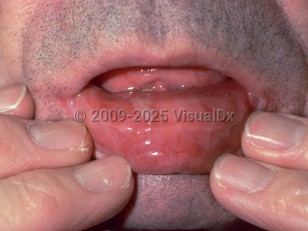Mucous membrane pemphigoid in Adult
See also in: Anogenital,Oral Mucosal LesionAlerts and Notices
Important News & Links
Synopsis

MMP is almost twice as common in females as it is in males, and it is seen most frequently in older individuals. MMP affects the mucous membranes and, less commonly, the skin. The mouth is involved most often (ie, painful erosions and ulcers), followed by the conjunctiva (corneal inflammation and scarring, conjunctiva inflammation, trichiasis, ectropion, symblepharon, ankyloblepharon, and blindness). See ocular cicatricial pemphigoid.
Skin, nasal, anogenital, laryngeal, pharyngeal, and esophageal mucosal surfaces can also be affected, leading to epistaxis, perianal erythema and scarring, phimosis or vaginal scarring, and hoarseness or dysphagia, respectively. Scarring is the endpoint for all sites of involvement except the oral mucosa, where it is less frequent.
Cutaneous disease, when present, most frequently accompanies mucous membrane disease. Occasionally, cutaneous blistering and scarring dominate the clinical picture (so-called Brunsting-Perry variant).
In a 2022 study, malignancies, especially solid organ tumors, were reported in up to 13.8% of patients. These include lung carcinoma, prostate cancer, penile cancer, breast cancer (female or male), endometrial cancer, vulvar carcinoma, and non-Hodgkin lymphoma. The malignancy rate was higher when autoantibodies against laminin-332 were found.
Codes
L12.1 – Cicatricial pemphigoid
SNOMEDCT:
34250006 – Cicatricial pemphigoid
Look For
Subscription Required
Diagnostic Pearls
Subscription Required
Differential Diagnosis & Pitfalls

Subscription Required
Best Tests
Subscription Required
Management Pearls
Subscription Required
Therapy
Subscription Required
Drug Reaction Data
Subscription Required
References
Subscription Required
Last Updated:07/25/2024

